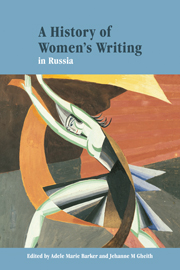Book contents
- Frontmatter
- Contents
- Notes on contributors
- Acknowledgments
- Note on transliteration
- List of abbreviations
- Introduction
- 1 Women's image in Russian medieval literature
- 2 Sappho, Corinna, and Niobe: genres and personae in Russian women's writing, 1760–1820
- 3 The inexperienced muse: Russian women and poetry in the first half of the nineteenth century
- 4 Women of the 1830s and 1850s: alternative periodizations
- 5 “A particle of our soul”: prerevolutionary autobiography by Russian women writers
- 6 The women of Russian Montparnasse (Paris, 1920–1940)
- 7 Women in Russian Symbolism: beyond the algebra of love
- 8 The eastern path of exile: Russian women's writing in China
- 9 Realist prose writers, 1881–1929
- 10 Women and gender in post-symbolist poetry and the Stalin era
- 11 Writing the female body politic (1945–1985)
- 12 In their own words? Soviet women writers and the search for self
- 13 Women's poetry since the sixties
- 14 The persistence of memory: women's prose since the sixties
- 15 Perestroika and post-soviet prose: from dazzle to dispersal
- Bibliographical guide to writers and their works
- Guide to further reading
- Index
5 - “A particle of our soul”: prerevolutionary autobiography by Russian women writers
Published online by Cambridge University Press: 22 September 2009
- Frontmatter
- Contents
- Notes on contributors
- Acknowledgments
- Note on transliteration
- List of abbreviations
- Introduction
- 1 Women's image in Russian medieval literature
- 2 Sappho, Corinna, and Niobe: genres and personae in Russian women's writing, 1760–1820
- 3 The inexperienced muse: Russian women and poetry in the first half of the nineteenth century
- 4 Women of the 1830s and 1850s: alternative periodizations
- 5 “A particle of our soul”: prerevolutionary autobiography by Russian women writers
- 6 The women of Russian Montparnasse (Paris, 1920–1940)
- 7 Women in Russian Symbolism: beyond the algebra of love
- 8 The eastern path of exile: Russian women's writing in China
- 9 Realist prose writers, 1881–1929
- 10 Women and gender in post-symbolist poetry and the Stalin era
- 11 Writing the female body politic (1945–1985)
- 12 In their own words? Soviet women writers and the search for self
- 13 Women's poetry since the sixties
- 14 The persistence of memory: women's prose since the sixties
- 15 Perestroika and post-soviet prose: from dazzle to dispersal
- Bibliographical guide to writers and their works
- Guide to further reading
- Index
Summary
“ … the great truth [is] that we love our past no matter what it gave us; … that the places where we left a particle of our soul, a fragment of our life, are sacred.”
ANASTASIIA VERBITSKAIAAutobiography plays a pivotal role in the dialog between past and present that we call history: our foremothers' first-person accounts are often the only records we have of past women's lives. Autobiographies and memoirs by Russian women developed in rhythmic interconnection with fiction. Women began publishing imaginative narrative prose in the first decade of the nineteenth century, and fiction has remained an important genre for them since the 1830s. The first recorded autobiographies by Russian women date from the last third of the eighteenth century, but early works even by public figures (those of Catherine II and Ekaterina Dashkova) circulated in manuscript and were published only decades after their authors' death.
Quantity is as remarkable as quality in the autobiographical legacy left us by prerevolutionary Russian women: at least 200 substantive works of retrospective life-writing, including memoirs of “great men,” “family chronicles,” and travel accounts, have appeared in print to the present day. In the literary-historical context, two points in time are important: when the work was written, and when it was published. The former tells us something about the contemporary culture, the models of writing about the self the author was subscribing to or contesting, and the audience she saw herself as addressing.
- Type
- Chapter
- Information
- A History of Women's Writing in Russia , pp. 100 - 116Publisher: Cambridge University PressPrint publication year: 2002



